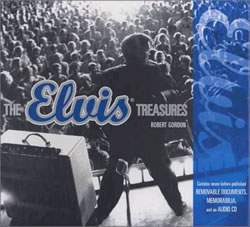The Elvis Treasures
About The Elvis Treasures
On October 3, 1945, ten-year-old Elvis Presley climbed atop a chair to reach the microphone and performed the song “Old Shep” for a crowd of several hundred at the Tupelo fair, coming in fifth place in the talent contest. Ten years later, the King created his first full-scale riot after an appearance in Jacksonville at a baseball park. Girls poured through an overhead window, catching the police off guard, and stole or shredded almost every stitch of clothing Elvis had on. He scaled the shower area and clung to the pipes overhead while fans clamored to touch and take home a piece of him.
Now Graceland has opened the doors to its extensive archives for the first time ever, allowing previously inaccessible historic documents and memorabilia to be reproduced in facsimile, collectible form. With biographical text by acclaimed Elvis expert Robert Gordon, The Elvis Treasures tells the King’s life story through handwritten letters, press releases, movie scripts, photographs and additional artifacts. Where else can you get a ticket to “Frank Sinatra’s Welcome Home Party for Elvis Presley,” evaluate the King’s hand-drawn football plays, read his first RCA contract, and check out a book that he borrowed from the Humes High School library as an eighth-grader? Published to coincide with the 25th anniversary of the Elvis’s death, this unique interactive book also contains a 60-minute CD of interviews spanning his career, providing a formerly unavailable portrait of the King in his own words.
The Elvis Treasures contains 22 removable documents, including:
rare promotional photos issued by Sun Records in 1954-55
a 1958 Christmas card from Elvis and the Colonel (as Santa)
Elvis’s letter to Anita, his Memphis girlfriend, expressing his love and commitment to her while he was stationed in Germany
an invitation to the premiere for Viva Las Vegas
telegrams Vernon received upon Elvis’ death from Johnny Cash, Isaac Hayes, Governor George Wallace, B. B. King, Little Richard and other
About the CD of 60 Minutes Worth of Interviews
The first interview, track 1, was conducted in 1955 by Mae Boren Axton, months before the song she gave him, Heartbreak Hotel, would become his breakthrough hit. Track 2, recorded roughly a year later, finds Elvis admitting, in an unguarded moment, that his performing style was inspired in part by the gospel quarters he’d always loved; it’s a confession that comes back to haunt him in the following interview, conducted in August 1956 by Paul Wilder of TV Guide (track 3). When Wilder uses the term-holy roller in asking him about the religious influence on his music, Elvis interrupts him—“I have never used that expression”— with the hair-curling command of a preacher. The TV Guide interview makes for fascinating listening, as Elvis uses charm, biting sarcasm, and the sheer force of his conviction to parry Wilder’s interrogation. Tracks 4 and 5 are far more joyful in spirit, as we hear first Elvis’s parents and then the singer himself tossed about in the maelstrom of his triumphant Tupelo homecoming concert in 1956. ( “Baby Play House,” his mother responds unforgettably when asked her favorite Elvis song.)
Then we jump ahead to Elvis– Army years and a montage of clips reflecting his life in the service, America’s reaction, and his return home (track 6). Elvis speaks earnestly about working the same details as the other soldiers, but by the end of the selection seems quite happy about returning to his normal life. Track 7 finds him back at work, in a brief interview on the set of Blue Hawaii. But what follows, an excerpt from a long conversation with Lloyd Shearer of Parade magazine (track 8), is perhaps the most introspective interview Elvis ever gave. (Elvis’s half of this conversation was released on the RCA boxed set Elvis Aron Presley as”An Elvis Moonsong.” Fans may enjoy hearing this excerpt in full, with Shearer’s quiet questions intact.) And the final two recordings, tracks 9 and 10, find Elvis at new conferences before his landmark shows at the Houston Astrodome (1970) and Madison Square Garden (1972) disarming the press with clever quips, and expressing his love of good old rock n roll that undying love of music that had always been with him.

